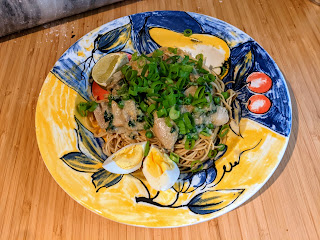Bierocks are buns stuffed with cabbage and meat. They sound delicious, but individually making and stuffing all of those buns sounds like a lot of work. Fortunately, symbol found this recipe in Cook's Country for a casserole version; rather than stuffing individual buns, an entire baking dish is filled and then topped with bread dough.
This was a great success, although we had to trim the dough somewhat after cooking to fit everything into the fridge.
Bierock Casserole
Cook's Country, April/May 2015
Ingredients
- Dough
- ¼+¾ C whole milk, divided
- 1 tbsp instant yeast
- 1 tsp + 5 tsp sugar, divided
- 2 C all-purpose flour
- 1¾ tsp baking powder
- ¼ tsp salt
- 2 tbsp butter, melted
- Filling
- 3 lbs lean ground beef1
- 1 small cabbage, cored and finely chopped, about 8 C
- 2 onions, finely chopped
- 1 tbsp all-purpose flour
- 6-8 oz (170-225g) American cheese or mild cheddar, chopped
- 2 tbsp yellow mustard
- 1 egg, beaten with 1 tbsp water
Directions
- Microwave ¼ C milk until warm, 15-20 seconds.
- Stir in yeast and 1 tsp sugar and let stand until bubbly, ~5 minutes.
- Whisk together flour, baking powder, salt, and remaining sugar in a large bowl.
- Add yeast mixture, melted butter, and remaining milk to form a sticky dough.
- Knead until it forms a smooth ball, ~2 minutes.
- Return to the bowl, cover, and rise for 30 minutes.
- While the dough is rising, heat 1 tbsp of oil in a large2 pot or dutch oven over medium-high heat.
- Add the beef, cabbage, and onions to the pot and cook, covered, stirring occasionally, for ~5 minutes.
- Uncover and continue to cook until beef is browned and cabbage is wilted, 10-15 minutes; if you are adding the cabbage in stages it may take longer.
- Mix in flour and cook for 1 minute.
- Drain (either by draining the pot or removing the filling to a bowl using a spider).
- Mix in cheese and mustard.
- Pour mixture into a 9×13" baking dish and let cool for 10 minutes; while cooling, preheat the oven to 375°F.
- Brush the rim of the dish with the egg wash.
- Roll dough out into a rectangle and drape over the dish.
- Fold sides in so that it is flush with the edges of the dish, and crimp edges.
- Brush with egg wash.
- Cut 9 venting slits into it.
- Bake until crust is golden brown and filling bubbly; 15-20 minutes.
- Let stand 20 minutes on a wire rack, then serve.
1 We used a roughly 1:1 mix of actual ground beef and Beyond Meat ground beef substitute, with great success. Back
2 I'm not kidding about the "large". If you can't fit everything in, add the meat first, break it up and cook it a bit, then add the cabbage a bit at a time -- it'll reduce as it cooks. Back





